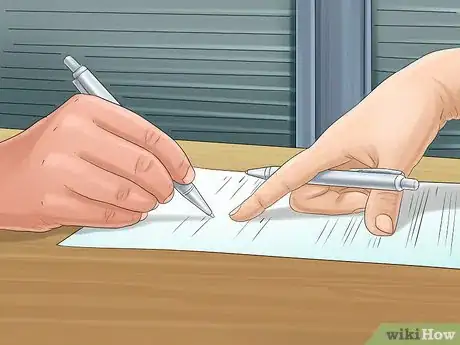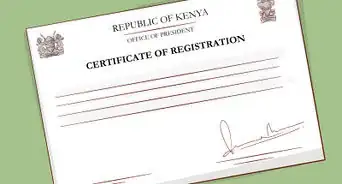This article was co-authored by Clinton M. Sandvick, JD, PhD. Clinton M. Sandvick worked as a civil litigator in California for over 7 years. He received his JD from the University of Wisconsin-Madison in 1998 and his PhD in American History from the University of Oregon in 2013.
wikiHow marks an article as reader-approved once it receives enough positive feedback. In this case, 95% of readers who voted found the article helpful, earning it our reader-approved status.
This article has been viewed 100,678 times.
A joint venture is a strategic alliance or agreement between two or more parties. The purpose of a joint venture is to allow both parties—usually companies—to increase their ability to build their separate businesses. Joint ventures are commonly created by companies to become active in a new territory and return higher profits by expanding the company’s network. If you have a company that wants to grow in this way, you need to research and define your needs, seek out a viable partner, and then carefully draft a joint venture agreement (contract) to create a strong partnership.
Steps
Planning for a Joint Venture
-
1Determine your need for a joint venture. In your regular business operations, you may reach a point when you have the need for expertise, technology or operations that your business is lacking. One way to solve this is through a joint venture with another company that has expertise or operations in that area.[1]
- For example, your company may focus on research and development of a new product, but you do not have the resources for distribution. You could form a joint venture with another company to share in the marketing and distribution of your product.
-
2Define your business objective. Once you have an idea, you need to state it clearly in objective business terms. Describe the purpose of the joint venture that you foresee and identify its goals. This will need to be a document that you can share with potential partners to generate interest. The need for the joint venture should be compelling and self-evident, in order to catch the attention of other companies.[2]Advertisement
-
3Research potential joint venture partners. Networking in the business community is a useful way to find potential partners. Shop around, meet with other business leaders, and focus on companies that provide the services or have the expertise that you need.[3]
-
4Network with other companies. Attending conferences and networking events in the business areas in which you want to find a strategic partner will give you a better idea of who your potential partners are and what you have to offer each other.
-
5Schedule follow up meetings. Networking events allow you to informally meet and exchange business cards, which gives you the opportunity to follow up with those individuals whose companies meet your needs. After you have met a number of people by networking, schedule follow up meetings with those people that you are most interested in working with. Be prepared to discuss the needs of your business as well as what your business has to offer the other company.
-
6Determine if the two companies are a “good fit.” A successful joint venture depends on more than just completing a task. You need to examine the operating structures of the two companies to see if they are compatible. Consider the following issues in making this decision:[4]
- Are the management structures of the two companies compatible?
- Are the employees of each company receptive and supportive of the joint venture?
- Are the two companies similarly, if not equally, committed to the success of the joint venture?
- Are both companies financially secure enough to support the joint venture?
- Do the two companies trust each other enough to work well together?
-
7Prepare a nondisclosure agreement. For a joint venture to be successful, the two companies will need to deal openly with each other, and sometimes this means sharing otherwise confidential information. You may choose to prepare a nondisclosure, or confidentiality, agreement before you begin the joint venture. This is a form of a contract by which both parties agree not to disclose or take advantage of anything obtained from the other company.
-
8Draft a letter of intent. After the groundwork has been laid, a letter of intent is often the precursor to the formal joint venture agreement. A letter of intent explains the general purpose of the joint venture and indicates each party’s intent to negotiate the final terms of the agreement. A letter of intent may be either a binding or a non-binding agreement.
- A binding letter of intent becomes a contract that sets forth certain rules that the parties will follow in negotiating the joint venture agreement. It will include all key terms to the deal and should address arbitration or some other method of resolving disputes that may arise.
- A non-binding letter of intent defines the expected joint venture and spells out the intentions of each party to negotiate the final agreement.
Deciding the Format of Your Joint Venture
-
1Review the scope of the overall undertaking. There are different forms that a joint venture can take, depending on the size of the project that you have in mind. You and your partnering company should review the purpose of the joint venture and its expected duration and then use that information to select your future course of action. The various forms of a joint venture may be a new corporation, a partnership, or a simple contractual agreement.
-
2Create a new corporation if the project is large. If the joint venture is something that you expect will last and perhaps grow even larger, you may decide to create a stand-alone corporation, to be owned equally (or in whatever proportions you choose) by the two joint venture partners. The newly formed corporation will need its own identity, officers and employees, although there may be significant overlap with the original companies.
-
3Form a partnership if you wish to retain individual identities. A joint venture can be a partnership, whereby the two original companies each retain their original identity. The joint venture agreement becomes a partnership agreement that will define how the partners will share liabilities and responsibilities.
-
4Draft a contract for a smaller or temporary project. If the joint venture is seen as a sort of one-time deal, then it may be best just to draft a joint venture agreement. The two companies retain their individual identities and just agree to join their resources and expertise for a specific purpose.
Drafting the Joint Venture Agreement
-
1Introduce the purpose of the joint venture and the parties. Most contracts begin by naming the parties to the agreement, with a brief description of each party’s operations. Then introduce the name of the new joint venture, and include a brief statement of its intended purpose.[5]
- The purpose is often stated early in the joint venture agreement: "The parties to this agreement, (A) and (B), are joining together to _____." The statement does not need to be particularly exciting. Just say what you are doing.[6]
-
2Define relevant terms. If there are particular terms of art or specific issues that are key to the joint venture, they should be clearly defined. This section may begin with a heading that actually says, “Definitions,” to set it apart from the agreement portion of the contract.[7]
-
3Identify the business objectives of the joint venture. This term will clearly state the purpose of the joint venture, to help keep the parties focused as the project moves forward.[8] You want to make your statement of the objective clear and defined so that the parties to the contract can identify when their task has been met.
-
4Define the structure of the joint venture. This will be the section of the contract that identifies the format you have selected. The parties to the joint venture need to discuss whether they will be creating some new business entity or remaining as independent agents working together.[9]
- If you are forming a new corporation, this section will identify that new corporation, its operating structure, officers, etc.
- If you are forming a partnership, you need to define how the partnership will share assets and liabilities.
- If the parties to the joint venture are retaining their independent identities but just joining forces through this contract, you still need to say something to that effect: "Each party to this joint venture agreement will remain independently responsible for its ongoing costs and expenses. Income from the joint venture will be shared equally, and each party will retain complete independence for tax purposes."
-
5Define the management of the joint venture. For the joint venture to succeed, the parties need to agree how they will run the operation. You need to decide if you will create a separate board of directors, elect officers, or set up a team of representatives. In this section, you should address the following:[10]
- the structure of the management
- procedures for appointing or selecting the managers
- compensation or fees for the managers
- management’s decision making responsibilities or limitations
- frequency and purpose of meetings
-
6Address financial issues related to the joint venture. You need to explain what each party will contribute to the joint venture, in terms of cash or other resources. You also need to define how the profits will be shared. Some considerations include:[11] [12]
- when profits will be paid out
- how profits are to be calculated
- what share of profits each party will receive
- how tax obligations will be shared and reported
-
7Define the role of employees in the joint venture. You will need to consider which company will contribute workers to the joint venture, and in what proportions. The agreement needs to identify which employees will perform specific functions and how the work of the joint venture will get done.[13]
-
8Agree on a procedure for resolving any controversies or disagreements. It is important in any joint venture that the parties anticipate the possibility of future disputes. The joint venture agreement needs to provide procedures that the parties will follow to resolve these problems.[14]
- Good faith negotiation. The first step should always be for the two parties to try to resolve any dispute between themselves.
- Mediation. Mediation is a system of guided negotiation. A neutral party is brought in to meet with each side and help guide discussions to bring about a resolution.
- Arbitration. Arbitration may be binding or non-binding. This is a sort of trial, and can sometimes be costly, depending on the scope of the dispute. The parties agree to a set of procedures, such as the American Arbitration Association Rules, and agree to present their dispute to a neutral third party, who will make a decision.
- Choice of law. It is important to identify which state’s laws will govern any dispute, particularly if the joint venture is large and the parties are from different states.
- Costs. Dispute resolution can be costly. It is important to define up front who will bear the costs, whether they will be split evenly, or paid for by the party raising the dispute.
-
9Define the duration and/or termination procedures. By its definition, a joint venture is usually temporary. You can define it either by a specified length of time, or by clearly stating the business objective so that when the objective is reached, the joint venture will be concluded. As part of this section, you may want to include the following:[15]
- A clear definition of the completion of the joint venture project. For example, a joint venture agreement between a marketing firm and an architectural firm might read, "This joint venture agreement remains in full force until the _____ building project has been completed and 100% of the ownership shares have been sold."
- A date when the project is to end. Alternatively, the parties could set a specific target date to terminate the joint venture. This would read, "This joint venture agreement remains in full force until May 1, 2018, unless the parties, by agreement, execute an amendment for a later or earlier date."
- The possibility of ending the joint venture if it becomes clear that the project is not succeeding. In this case, you need to define clearly what “not succeeding” means, and whether the parties must agree or if either party may make this decision.
- Consider periodic reviews. You may want to define a review team that will meet periodically (weekly, monthly, annually) depending on the scope of the project, to determine whether the objectives of the joint venture are being met and whether termination should be considered.
-
10Include a confidentiality clause. If the parties executed a nondisclosure or confidentiality agreement at the outset of the joint venture, then the formal joint venture agreement may incorporate that document by reference or may repeat similar terms.[16]
- Incorporation by reference would say something like, “The nondisclosure agreement, executed by the parties and dated ______, is hereby incorporated in its entirety and shall continue in effect for the duration of this joint venture agreement.”
-
11Conclude the agreement with signatures. The joint venture agreement must be signed by representatives of each party with authority to enter into the contract. Each party, or its attorney, should keep a copy of the final agreement.
References
- ↑ http://www.nolo.com/legal-encyclopedia/what-joint-venture.html
- ↑ http://www.nolo.com/legal-encyclopedia/how-do-i-start-joint-venture.html
- ↑ http://www.nolo.com/legal-encyclopedia/how-do-i-start-joint-venture.html
- ↑ http://www.nolo.com/legal-encyclopedia/how-do-i-start-joint-venture.html
- ↑ https://www.upcounsel.com/joint-venture-agreement
- ↑ http://www.nist.gov/tip/cur_comp/upload/sample_joint_venture_agree_032010.pdf
- ↑ http://www.nist.gov/tip/cur_comp/upload/sample_joint_venture_agree_032010.pdf
- ↑ http://www.nolo.com/legal-encyclopedia/what-joint-venture.html
- ↑ http://www.nolo.com/legal-encyclopedia/what-joint-venture.html
- ↑ https://www.upcounsel.com/joint-venture-agreement
- ↑ https://www.upcounsel.com/joint-venture-agreement
- ↑ http://www.nolo.com/legal-encyclopedia/what-joint-venture.html
- ↑ http://www.nolo.com/legal-encyclopedia/what-joint-venture.html
- ↑ http://www.nolo.com/legal-encyclopedia/what-joint-venture.html
- ↑ http://www.nolo.com/legal-encyclopedia/what-joint-venture.html
- ↑ http://www.nolo.com/legal-encyclopedia/what-joint-venture.html
About This Article
A joint venture is a strategic partnership between 2 businesses that benefits each business. For example, if a company has a new product but no way of distributing it, they could partner with someone who specializes in distribution. If you're interested in creating a joint venture, you can look for a joint venture partner by attending networking events and conferences in your business community. Once you have found a company that’s a good fit, you should draft a letter of intent stating the purpose of the joint venture as well as both of your intents to negotiate final terms in an agreement. Then, you should decide if your joint venture will be a new corporation, a partnership, or a simple contractual agreement. For more advice from our Legal co-author, including how to draft a joint venture agreement, read on!






















































































